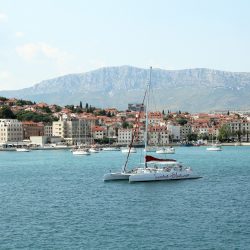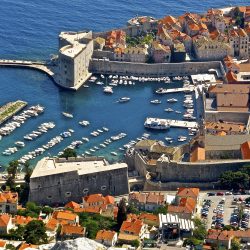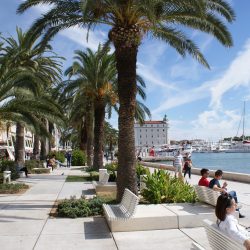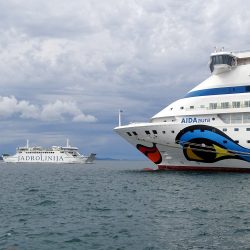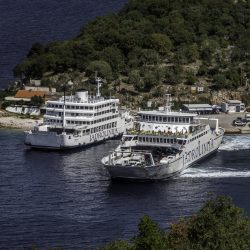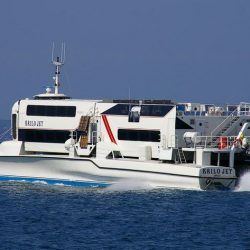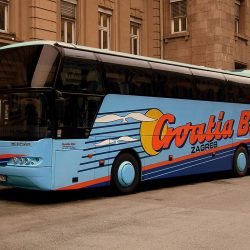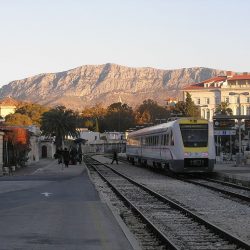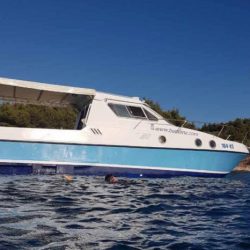Croatia’s coastal region of Dalmatia is truly breathtaking. Rugged limestone cliffs, hues of turquoise sea and millennium-old cobblestone streets provide you with a trip you’ll never forget. The coastline and its many islands span 348km from Zadar to Dubrovnik.
Here we explain the best ways to get around.
Quick links:
Where should I go in Dalmatia?
What are popular places to visit in Dalmatia?
What are my transport options in Dalmatia?
What’s the quickest way to travel in Dalmatia?
What’s the cheapest way to travel in Dalmatia?
What’s the best way to travel in Dalmatia?
Travelling the Dalmatian coast by boat
Travelling the Dalmatian coast by bus
Travelling the Dalmatian coast by train
Related article: read Rome2Rio’s Jadrolinija Croatia ferry guide
Where should I go in Dalmatia?
Dalmatia has thousands of options for different travellers’ tastes and budgets. The region is lined with picturesque coastal towns and mountainous hinterland, and has more than 70 islands and 500 islets as well as four national parks. Whether it’s swimming in pristine lakes on Mljet island, picking fresh lavender in Hvar or touring UNESCO World Heritage sites in Split, the Adriatic coast has something for everyone.
TRAVEL TIP: Croatia has been part of the EU since 2012, but the currency is still Kuna.
What are popular places to visit in Dalmatia?
If you’re interested in historical cities, head to Split, Dubrovnik, Šibenik and Zadar. Popular islands include Brač, Korčula, Hvar and Vis. Nature enthusiasts and hikers should head to these national parks: Paklenica, Krka, Mljet and Kornati.

What are my transport options in Dalmatia?
Hit the motorway to travel fast and avoid traffic jams, or for a more affordable trip, hop on a bus. You’ll need to take a ferry or catamaran to get from the mainland to the islands or to travel within archipelagos. All these transportation options are reliable and comfortable.
What’s the quickest way to travel in Dalmatia?
The quickest way to get from city to city is by car on the motorway. The 348km route from the centre of Zadar in the north to the old town of Dubrovnik in the south takes about 5 hours.
Though this route has the least amount of traffic in the peak summer season, you’ll mostly be driving beneath the northern slopes of Biokovo mountain, which means you’ll miss most of the sea views.
En route to Dubrovnik, you’ll need to cross a small strip of Bosnian territory (20km). Keep your passport/ID to hand, as you’ll be back in Croatia in about 10 minutes. During peak season, traffic here is heavy.
What’s the cheapest way to travel in Dalmatia?
Bus is the most economical. You can cover most of the Dalmatian coast and hinterland by buses that run day and night. There’s a number of different operators; they all offer similar pricing and amenities.
Search all Dalmatia bus routes and operators
What’s the best way to travel in Dalmatia?
If you’ve got time to explore local history, culture and nature, your best bet is driving the magistrala (coastal road).
The 368km route from Zadar takes you south through Šibenik and Split and other smaller villages and towns all the way down to Croatia’s border with Montenegro. The drive gives you the chance to enjoy breathtaking views, stop for a swim at the beach or visit national parks along the way.
TRAVELLING THE DALMATIAN COAST BY BOAT
Travelling Dalmatia by boat is more accessible than ever. Besides regular ferry services provided by state-owned sea shipping company Jadrolinija, there are a number of other boat companies that cover the majority of Dalmatia’s inhabited islands.
Where do I catch the ferry from?
Zadar, Šibenik, Split and Dubrovnik are Dalmatia’s main ferry ports. If you’re based in a smaller town or village (even up to 100km away from a large port), you’ll need to drive or take a bus to the port first and then hop on a boat to your island of choice.
There are also several smaller ports in Dalmatia that transport to nearby islands (Biograd na Moru, Vodice, Trogir, Makarska and Ploče).
Depending on the island you wish to visit, each ferry port connects with local archipelagos. Popular examples include Šibenik – Zlarin, Split – Hvar, Dubrovnik – Mljet. Or search all Dalmatia ferries here.
Can I island hop without going to/from the mainland?
Depending on the island route you wish to take, it is possible to hop from certain islands to others, but mostly within the same archipelago.
Planning multiple destinations into a single search on Rome2Rio is easy. Select more than two destinations by clicking on the + sign in the TO box. Next to the +, you will notice an x, which allows you to delete any extra stops you have added. See below for the Silba – Olib – Premuda route:

What are Dalmatia’s top ferry/catamaran services?
- Jadrolinija – has 31 lines in the Zadar, Šibenik, Split and Dubrovnik areas.
Read Rome2Rio’s review of Croatia’s national shipping company here. - Kapetan Luka – connects Split with the islands of Hvar, Korčula, Mljet, Vis and the port of Dubrovnik
- G&V Line Dubrovnik – connects Dubrovnik with Mljet, Korčula, Šipan and Lastovo islands (connections to certain islands are only available in July/August)
- G&V Line Iadera – connects Zadar with the islands of Iž, Rava and Dugi Otok
- Mia Tours – connects Zadar with the islands of Silba, Olib and Premuda
- Linijska Nacionalna Plovidba – connects Split with the islands of Šolta, Žirje and Kaprije, and the port of Šibenik on the mainland
- Bura Line – connects Trogir and Split ports to Čiovo island
- UberBoat – any route you choose, on demand
How do I choose an operator?
First, you need to decide where you want to go. The major differences come down to the length of the trip, as foot-passenger catamarans (katamaran in Croatian) will travel almost twice as fast as large car ferries (trajekt in Croatian). The best and most frequent operator for the popular routes is Jadrolinija, though timetables and length of transit compare with other available operators on certain routes.
Search your route on Rome2Rio and select ferry to see your operator options. For example, if you want to travel from Split to the island of Šolta, simply type in your route to check your ferry options.
You can book most ferry and catamaran lines directly on the operator’s website, or at the small ticket booths at ports. During the peak summer season, you may want to purchase your ticket a couple of days before your chosen travel date. Occasionally, the ticket office will tell you to purchase your ticket on board.
TRAVELLING THE DALMATIAN COAST BY BUS
Zadar, Split, Šibenik and Dubrovnik are Dalmatia’s biggest bus terminals, from where you’ll find the most connections to other places in the region. Certain towns and villages are exclusively connected to these major cities, making changing at a major bus terminal a must when getting from point A to B.
What are the best bus operators in Dalmatia?
Major bus companies that operate across the Dalmatia region are:
- Autoherc – Autopoduzeće Imotski
- Croatia Bus – Globtour – Salinea
- Autotrans/Arriva
- Promet Makarska
- Samoborček
- Flixbus
How do I choose a bus operator?
Type your search into Rome2Rio and select bus to see your operator options.
For example, if you want to travel from Split to Dubrovnik, simply type in your route to see all your bus options. Take your pick based on your preference of departure/arrival time, amenities, frequency, cost, etc.
What amenities do buses have?
| WiFi | Charging outlets | AC | Luggage storage | WC | |
|---|---|---|---|---|---|
| Autoherc Autopoduzeće Imotski |
Yes | No | Yes | Yes* | Yes |
| Croatia Bus Globtour Salinea |
Yes | Yes | Yes | Yes* | No |
| Autotrans | Yes | No | Yes | Yes* | No |
| Promet Makarska | Yes | No | Yes | Yes* | Yes |
| Samoborček | Yes | No | Yes | Yes* | No |
| Flixbus | Yes | Yes | Yes | Yes* | Yes |
| * Additional fee for luggage storage | |||||
How long will the bus take from the north to the south of Dalmatia?
A bus trip from Zadar to Dubrovnik via the coastal road could take up to 10 hours, depending on traffic. There are few direct buses from north to south (most require a change in Split); the quickest journey is about six hours.
How often do buses normally stop for breaks?
Most buses stop for a 15-minute break every 2 hours.
Where can I find bus timetables?
You’ll find them on the website of the bus station you’re travelling from and on large bus operators’ websites. Alternatively, just ask the staff at ticket booths at the bus station.
Where can I buy bus tickets?
Most operators sell tickets online, or you can buy them in person at the bus station’s ticket office on the day of your journey, as well as in advance. You can also purchase tickets from the bus drivers directly (smaller stations only).
If you’re looking to purchase last-minute bus tickets, many stations may not accept credit or debit cards, so make sure to have cash on you. Book ahead to ensure a seat.
Are there any additional costs?
When boarding buses in Croatia, you’ll usually be charged an extra €1.50 (10 Kuna) apiece for luggage storage. It’s important to note that drivers accept cash payments only in Kuna.
TRAVELLING THE DALMATIAN COAST BY TRAIN
Most travellers avoid Croatia’s inefficient railways system and opt to travel by bus. The reason: trains are extremely slow, with frequent stops and changes, they don’t run as frequently as buses and they don’t cover the entire region. The main train stations are Zadar and Split.
Where can I buy train tickets?
If you’re interested in the experience, you can find timetables and train information on the Croatian National Railways website. The train from Zadar to Split will cost you about 120 Kuna – buy your tickets via their app or at ticket booths at the train stations.
Getting around Croatia’s Dalmatian Coast was originally published 10 January 2018.

